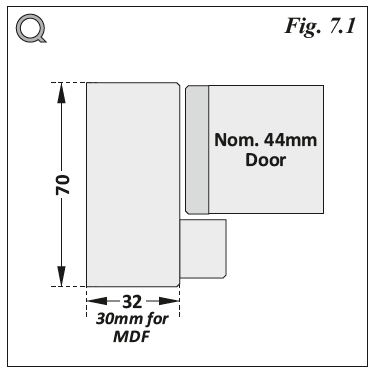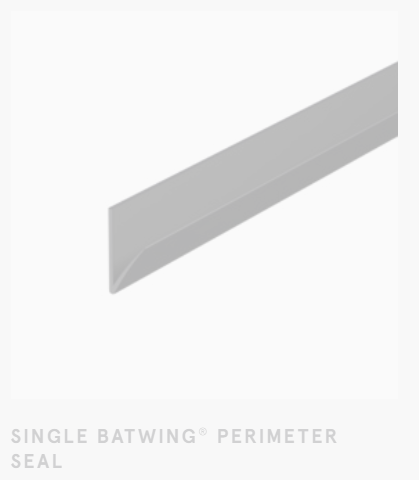-
Posts
379 -
Joined
-
Last visited
Everything posted by Neil Ashdown MAFDI
-
I am not aware of any fire risk issue with plastic finger guards fitted to timber-based fire doors. This might be useful https://www.enfielddoors.co.uk/finger-safe-guards-for-fire-doors/#:~:text=Care environments&text=Adults are susceptible%2C too%2C especially,for adults with special needs.
-

Fire door Frame thickness and Seal question
Neil Ashdown MAFDI replied to TONY74's topic in Fire Doors and Accessories
Hi Tony, All good thanks 🙂 Q1) I have been looking at our companies documents on on our fire door survey sheets it requests frame thickness. What does this refer too and how would it be measured please. Again we have no certificates or O&M manual for this door. A1) The door frame thickness and material is important so that it complies with the certification for the fire door leaf but clearly without certification to refer to you can't check it. If there's a Certification label or plug on the door leaf you may be able to trace the door leaf to the manufacturer and obtain the certification. The thickness of the door frame is commonly minimum 30mm thick. Q2) I have also noticed on one of our double leaf sets. Around the frame it has 1 x 20mm intumescent seal. Where the door meets on the closing edge it has 1 x 10mm. Surely this is in correct? Again we have no certificates or O&M manual for this door. A2) Usually there would be one 20mm intumescent seal in the meeting edge of the main leaf or possibly one 10mm seal in both meeting edges but offset, not opposing eachother. Again you need the door leaf certification to find out the exact specification. -

Intumescent kit around lock
Neil Ashdown MAFDI replied to Ronan's topic in Fire Doors and Accessories
Not mandatory but useful for filling gaps in untidy mortice work. The fire door leaf installation instructions/product data sheet should provide information where these are required. -

Gaps between Botton of jambs and F.F.L remedial?
Neil Ashdown MAFDI replied to a topic in Fire Doors and Accessories
Assuming the door frame jambs are timber. Then insert solid timber pieces, of the same type as existing, using urea formaldehyde based adhesive to tightly plug the gaps completely with no voids. -

importance of gaps in fire doors
Neil Ashdown MAFDI replied to Ronan's topic in Fire Doors and Accessories
Referenced in BS 8214: 2016 Timber-based Fire Door Assemblies: Code of Practice https://knowledge.bsigroup.com/products/timber-based-fire-door-assemblies-code-of-practice/standard but not necessarily a legal requirement -
There are better ideas: For FD30 doors the intumescent seal may be interrupted at the hinge positions (3 @ 100mm) and single lock/keep. For FD60 one of the twin the intumescent seals can be located to by-pass hinges due to the extra thickness door leaf. For smoke sealing use a seal that is attached to the door frame rebate stop, therefore continuous without interruption.
-
This might help http://firstglass.ie/wp-content/uploads/2019/03/Pilkington-Pyroshield-Pyroshield-2-Comparison.pdf Wired glass has traditionally been cut from larger sheets (thus no marking) and used for glazing of fire doors and screens where fire protection is required. The glass will crack in a fire but its fire rating is provided by the wire holding the glass together and this type of glass can be found widely in timber fire doors and glazed screens. In recent years the products have been improved - see Pyroshield 2 (above link) and Pyrostem https://www.pyroguard.eu/all-products/pyrostem/ The GGF guide provides best practice guidance for selecting products and installing them where 'fire rated glazing systems' are required.
-
To be suitable for a timber-based fire door the night latch needs to be Fire Rated CE / UKCA marked to BSEN12209 and of course compatible with the door leaf in question. Once the one ordered arrives we may be able to check. Good luck.
-
https://www.ggf.org.uk/publications/fire-resistant-glazing-publications/guide-best-practice-specification-use-fire-resistant-glazed-systems/
-

importance of gaps in fire doors
Neil Ashdown MAFDI replied to Ronan's topic in Fire Doors and Accessories
https://www.firedoorscomplete.com/training-qualification We would be please to help. -
Thanks Mike, Excellent, we will buy one and let you know how we get on.
-
Hi Mike, Strebord doors with Euro and oval cylinders up to 1400mm up which is good, but as you say it depends on the evidence for the door. But not for cylinder rim night latches, nada. Unfortunately. If you find one please let me know, that would be really useful. Thanks 🙂
-
These days cylinder rim night latches are not fitted to fire doors. There are three main reasons: 1) Lack of availability of fire rated cylinder rim night latches. 2) The installation height for a night latch is usually higher on the door than permitted by the fire test evidence for the fire door leaf. 3) The lock cylinder requires a large diameter hole through the door and this may adversely affect the fire resistance performance of the door. However, its possible that the existing door and lock combination was accepted by Building Control at the time of installation.
-
Unlatched doors are easier to use and provide a more efficient escape route. Therefore, so long as the self-closing devices are strong enough to hold the unlatched doors closed in draughty conditions I would advocate unlatched doors.
-
If the doors are fire resistant they should be checked regularly (three-monthly in residential blocks over eleven metres in storey height) and any damage should be repaired. The glazing system should be confirmed as fire resisting.
-
Given that the flat entrance doors need to be fire rated.............. Initially, I would consult the manufacturer of the ablative batt and sealant system for evidence of fire resistance performance including the penetrations. I would use this evidence to satisfy myself that the batt with fire-stopped penetrations meets the necessary fire and smoke resistance requirements, so that the over-boarding on both sides is additional to fire performance rather than integral to it. With regard to over-boarding the batt I would use a fire resistant cement based board on both sides. I would have an open-mind just in case a batt & sealant system proves unsuitable and a masonry based solution is necessary.
-

How to fix gaps in fire door
Neil Ashdown MAFDI replied to Ronan's topic in Fire Doors and Accessories
In terms of compliance, it depends on the circumstances. For flat entrance doors in blocks over 11 metres storey height Government guidance can be found here: https://www.gov.uk/government/publications/fire-safety-england-regulations-2022/fact-sheet-fire-doors-regulation-10 In terms of compliance with the relevant standard, BS 8214: 2016 Timber-based fire door assemblies - Code of practice you would need to consult the installation instructions for the fire door in question. To answer your specific questions: 1) The 12mm threshold gap exceeds the usual requirement of 10mm for fire resistance performance and 3mm for restricted spread of cold smoke. You could install a threshold plate to the floor to reduce the gap under the door and a flexible seal to seal the gap for smoke purposes. 2) The gaps between the door leaf and door frame at the top and vertical edges should be between 2mm and 4mm. You could adjust the fit of the door leaf in its frame to achieve those gaps. 3) You could replace the intumescent strips to rectify the very small gap where they stop short of the hinges. Different intumescent strips can vary in the way they intumesce so its best practice to replace them as a set. You will require cold smoke seals too. 4) The intumescent pads fit behind the hinge blades between the hinge and the timber door and frame. In a severe fire they can act as a gasket to restrict the rate of char to the timber from the metal hinges. -

Fire Door Frame Adjustment
Neil Ashdown MAFDI replied to streeldn's topic in Fire Doors and Accessories
The gap between the door frame and surrounding wall should be sealed in accordance with the requirements of BS 8214: 2016 Timber-based Fire Door Assemblies - Code of practice. Use non-combustible materials such as mineral fibre & intumescent mastic to seal the gap(s) and consult a specialist where necessary. -
Whilst there are no specific regulations in this regard, it would be usual to consult the product certification data sheet for the door. In the absence of such certification best practice would be to use hardwood of minimum 640 kg per cubic metre density, 6mm minimum thickness and 18mm maximum with the work carried out to a joinery-works standard and using urea formaldehyde based adhesive.
-
The product data sheet for the particular model of door leaf will provide information about the exact fire seal requirements. Generally speaking a firmly closed fire door is unlikely to be adversely affected by having seals that are 5mm wider that those specified.
-
You don't say whether the bedrooms open on to a communal area or are located within a flat? Usually bedroom doors inside a flat will be FD20 and not have smoke seals fitted (unless its a large flat) whereas bedroom doors that open onto communal areas will be FD30(s) with smoke seals fitted to restrict smoke logging in the corridor/hallway to provide for safe escape. Furthermore, perimeter smoke seals fitted to doors will not completely stop smoke spread (only restrict it) because leakage will take place at the hinges and lock positions and under the door. Clearly, additional fire detection would improve the situation but in any event you would be advised to speak with the inspector in detail for clarification about how best to provide the safest solution.
-
When changing from rising butt hinges to fire rated butt hinges the chamfer on the top edge of the timber-based fire door will need to be removed and and a suitable hardwood lipping fitted to the top edge to provide for the correct gap with the door frame head. Suitable adhesive should be used to fix the lipping. The fire and smoke rated letter-box should be one that is suited to a fire door with a tubecore chipboard core, some are not. A tubecore door will have timber stiles, top rail and bottom rail with hardwood lipping to the vertical edges, so if these are intact it will be possible to groove the top and vertical edges to fit fire seals. Don't forget smoke seals too. Having said all of that, tubecore fire doors are not best suited to use for flat entrance doors and you may wish to consider replacing it with a complete purpose-made fire door-set.
-

Fire Doors - Normal Door Frame
Neil Ashdown MAFDI replied to Red's topic in Fire Doors and Accessories
So based on Mike's post above (28mm thick door frame jambs for use with a Halspan Optima door leaf) and using a 762mm wide door leaf, the over-all door frame width would need to be 824mm. Check the door frame requirements for the door leaf you intend to install.




